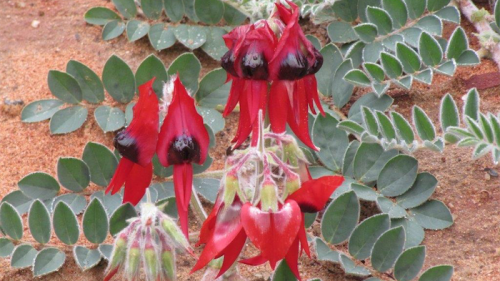
THE Red Centre Garden, at the Botanic Gardens, is a great, underrated tourist attraction.
The best time to visit the amazing Red Centre Garden is on a really hot day of, say, 35C-38C or more, although in reality in the real desert the temperatures are more likely 45C+.
“The Red Centre is the physical and symbolic heart of Australia,” says the entry board.
“It is a land of beauty, endless plains and stunning natural monuments, steeped in Aboriginal heritage with distinctive plants and animals.
“This garden showcases the dramatic landscape with elements of sand-dune country, rocky escarpments and desert rivers.”
Starting in 2012, it was an amazing challenge to create a desert garden in Canberra, reflecting as it does the country within 500km around Alice Springs.
Desert plants can be seen here that could only be seen by travelling a few thousand kilometres.
For example, Swainsona formosa or Sturt’s Desert Pea, pictured here, which grows on the median strips of Alice Springs and flowers most of the year.

One area of research at the Gardens is using micrografting techniques; as an example, Sturt’s Desert Pea uses NZ’s Clianthus puniceus as stock, resulting in it surviving the Canberra winter.
However, the conditions are completely different at the Botanic Gardens to the home garden in Canberra. The Gardens are a micro-climate in themselves and many plants in this living museum wouldn’t survive elsewhere in the district.
Although the Red Centre Garden needs to be better signposted, especially for overseas visitors, one of its features is the children’s trail, where they can track native animals and not be too frightened by the super-enlarged versions reminiscent of the dinosaur age.
If ever in Alice Springs, visit The Olive Pink Botanic Garden and the outstanding Alice Springs Desert Park.
THE Australian Native Plants Society grows a staggering 600 different species, cultivars and forms that are suitable for Canberra and Queanbeyan gardens. With this in mind, an important diary date is its autumn plant sale at the Gardens, from 8.30am, on March 19. While it may seem a long way off, autumn is planting time and I am reminding native plant lovers early. Bring your own bags or boxes.
WE certainly have had central-Australian summer temperatures followed by several weeks of sub-tropical Darwin type monsoonal weather. The problem with storms dumping huge amounts of rain in a short time is that most of it runs off into the storm-water drains while washing chemical pelletised fertilisers from gardens into the lake (thus contributing to blue-green algae). In addition, chemical fertilisers kill worms and many other microbes in the soil. Fortunately, between storms we have had some steady soaking rain, which augers well for autumn planting. Autumn is also plant-feeding time.
Jottings / fertilisers
- Blood and bone was considered an essential organic fertiliser in its original form and safe, even for native plants. However, extreme care should be taken with current products sold under this name as often some inorganic material is added in manufacture.
- Cow manure is an ideal fertiliser because the way the cows chew the cud they destroy any weed seeds, whereas horse or sheep manure can have an abundance of weed seeds.
- Maxicrop Liquid Seaweed Plant Nutrient, which encourages root growth, is suitable for native plants.
- Likewise, Neutrog’s Seamungus, a combination of seaweed and chook poo (not from battery hens) is a Biological Farmers Australia Certified Organic product.
Who can be trusted?
In a world of spin and confusion, there’s never been a more important time to support independent journalism in Canberra.
If you trust our work online and want to enforce the power of independent voices, I invite you to make a small contribution.
Every dollar of support is invested back into our journalism to help keep citynews.com.au strong and free.
Thank you,
Ian Meikle, editor




Leave a Reply